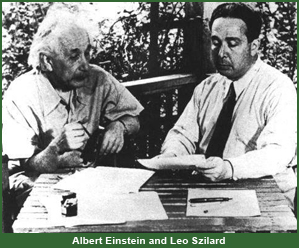
Time Periods
1890s-1939:
Atomic Discoveries
1939-1942:
Early
Government Support
1942-1944:
The Uranium
Path to
the Bomb
1942-1944:
The Plutonium
Path to
the Bomb
|
As the news of the fission breakthrough spread from Berlin in early 1939, many physicists within the United States (and elsewhere) immediately realized the potential danger posed by atomic energy. Especially concerned were émigré physicists who had fled their native countries because of the expansion of Nazi Germany and sought to obtain governmental support for further, secret nuclear research. Convincing busy government officials of the seriousness of this esoteric new scientific development was at first slow going. One month before the Second World War formally began with the September 1, 1939, invasion of Poland by Nazi Germany, Leo Szilard enlisted the help of Albert Einstein in personally calling President Franklin Roosevelt's attention to the matter. Roosevelt responded by creating a government committee to coordinate and provide modest funding for early uranium research. Work also proceeded during this period on the design of an atomic pile that could demonstrate the potential of atomic energy and possibly provide a second path to the atomic bomb besides uranium.
Sources and notes for this page. The text for this page is original to the Department of Energy's Office of History and Heritage Resources. The photograph of Albert Einstein with Leo Szilard is courtesy the Federation of American Scientists. Click here for information on the photograph of the 1940 meeting at Berkeley. The photograph of President Franklin Roosevelt signing the declaration of war on Japan, December 8, 1941, is courtesy the National Archives.
Home |
History Office
|
OpenNet
|
DOE
|
Privacy and Security Notices |



